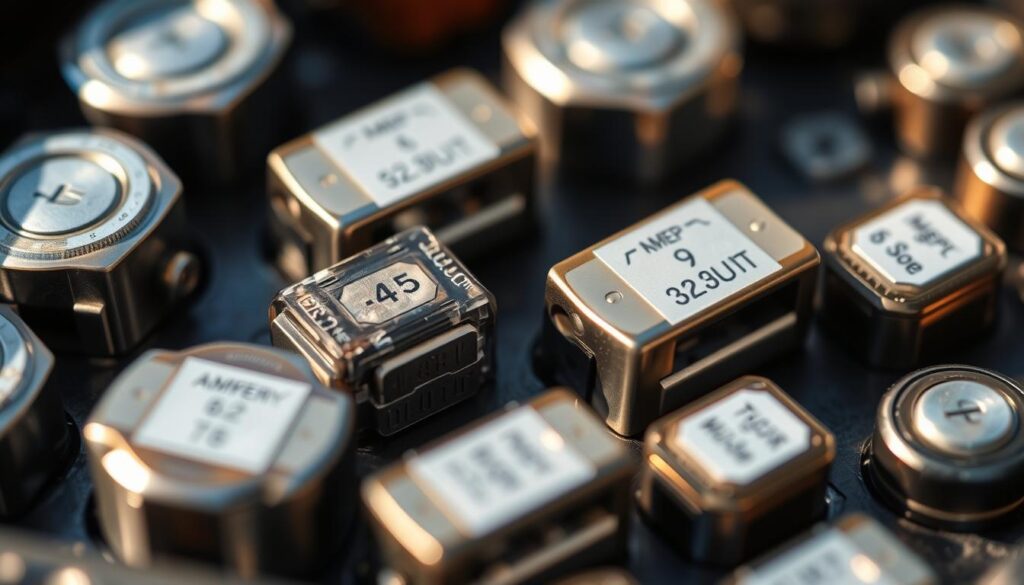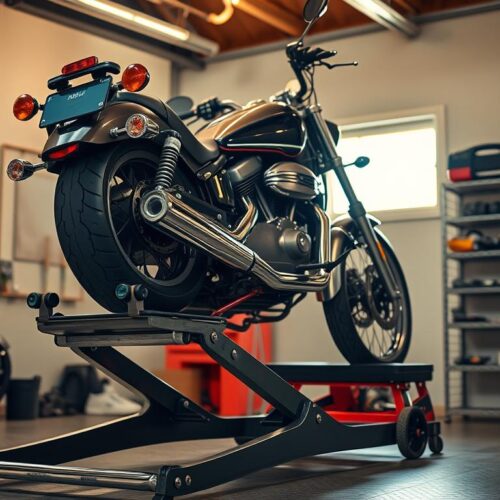Welcome to the beginner’s guide on motorcycle fuses. It’s key for those new to motorcycle maintenance. Fuses are vital for safety and making sure your bike works right. They save your motorcycle from electrical problems that could cause big troubles.
This guide will give you the info to handle electrical issues with confidence. Knowing the basics helps keep your ride safe and smooth. So, let’s learn about motorcycle fuses and how they guard your journey.
Understanding the Function of Motorcycle Fuses
Motorcycle fuses play a vital role in your bike’s electrical system. They act as protectors against electrical issues. These challenges could harm your motorcycle’s electrical parts.
When too much current flows, a fuse will cut off that current. This action stops electricity flow and protects your bike from electrical damage. It’s a way to keep your motorcycle safe from electrical surges.
Knowing how motorcycle fuses work helps you care for your bike’s electric system. Checking these fuses regularly can spot problems early. This ensures your motorcycle runs smoothly without problems.
Types of Motorcycle Fuses Available
When looking at motorcycle fuses, you mainly have blade fuses and glass tube fuses. Blade fuses are small and easy to install because of their flat shape. This makes them quick to replace and favored by many riders.
Glass tube fuses let you see if they are working right or not. Just by checking the glass, you can tell if a fuse is good or needs changing. Each type is suited for different needs because they have different amperage ratings. This affects which electrical systems they work best with on motorcycles.
| Type of Fuse | Design | Visibility | Common Uses |
|---|---|---|---|
| Blade Fuse | Compact and flat | Limited visibility | General electrical systems |
| Glass Tube Fuse | Cylindrical | Clear visibility | Lighting and accessory circuits |
Identifying the Right Fuse for Your Motorcycle
Choosing the right fuse is key to keeping your motorcycle running smoothly. Always start by checking your motorcycle’s owner’s manual. It has clear details on the fuses your bike needs. It’s also important to know your fuse box well.
The fuses have color-coded tabs that show their amperage. Each color means a different strength, making it easy to pick the right one. This step helps avoid electrical issues later.
Before you swap out a fuse, make sure to turn off the engine and all electrical parts. This is a safety step to prevent shocks or damage. Learning to replace a fuse correctly helps with better bike upkeep.

How to Inspect and Replace a Fuse
Knowing how to check your motorcycle’s fuse is key to keeping the electrical system running smoothly. Start by looking at the fuse for signs of wear. If the glass looks discolored or the filament is broken, the fuse is bad. Spotting these problems early makes fixing them easier.
Here’s how to change a fuse:
- Turn off the motorcycle and make sure it’s on flat ground.
- Find the fuse box, usually under the seat or by the battery.
- Take out the old fuse with a fuse puller or fingers, but be gentle with the fuse holder.
- Look at the old fuse for the amperage rating and pick a new one that matches.
- Make sure the new fuse is snug to keep the electrical connection strong.
Regular checks and replacing fuses when needed is a smart way to stay safe. It also keeps your motorcycle’s electrical parts working longer.
| Step | Action | Notes |
|---|---|---|
| 1 | Turn Off Motorcycle | Always ensure safety by powering down. |
| 2 | Locate the Fuse Box | It can usually be found under the seat. |
| 3 | Remove Old Fuse | Use a fuse puller for best results. |
| 4 | Insert New Fuse | Match the amperage rating exactly. |
| 5 | Secure Fit | Ensure the fuse is securely in place for optimal function. |
Signs of a Blown Fuse
Knowing how to spot a blown fuse can keep your motorcycle running smoothly. If electrical parts like headlights or taillights stop working, it’s a big hint. This situation often means a fuse has blown.
You might also notice a strange smell near the fuse box. A burnt scent usually points to an electrical issue, often a blown fuse. Looking at the fuse box for damage, like dark marks or melted areas, helps too.
Spotting these signs early helps you fix problems quickly. This keeps your motorcycle safe and ready for your next adventure.
Understanding Fuse Ratings and Specifications
Fuses have a specific amperage rating. This tells you the max current they can handle before they break the circuit. It’s key for the safety and workings of your motorcycle’s electrical system. When picking a fuse, it’s crucial to match this rating with the electrical load of your motorcycle.
Using the wrong fuse rating can cause issues. You might end up with blown fuses that can leave you stuck. Or, you could have not enough protection against electrical surges. This could harm your motorcycle’s sensitive parts.
To help you understand fuse ratings better, consider the following table. It summarizes different fuse ratings and what they mean for your motorcycle:
| Fuse Rating (Amperage) | Typical Applications | Risks of Incorrect Ratings |
|---|---|---|
| 5A | Lighting circuits | May blow frequently if load increases |
| 10A | Accessory circuits | Inadequate for high-drain accessories |
| 15A | Ignition systems | Possible damage to wiring if too high |
| 20A | Fuel pump or starter motor | Risk of overheating components |

How to Manage Electrical Accessories
When adding extras to your motorcycle, like lights, GPS, or sound systems, pay attention to the electrical system. You must plan extra carefully. Each new part should have its own fuse for safety.
First, figure out how much power all new accessories will use. This check helps make sure you don’t exceed the bike’s electrical limits. Always look at your motorcycle’s manual to understand its electrical needs for safe upgrades.
When adding accessories, remember these tips:
- Check the power requirements of each accessory.
- Use a multimeter to measure voltage and ensure proper connections.
- Prioritize installing components that use less power to avoid overloading.
- Inspect connections and fuses often to catch any problems early.
By sticking to these rules, you can add to your motorcycle’s gadgets safely. This way, you keep the bike’s electrical system reliable.
Common Mistakes to Avoid with Fuses
Many riders mess up with motorcycle fuses, which leads to annoying electrical issues. A big mistake is not checking your fuses often. This might make your electrical system fail unexpectedly when riding, putting you in a tough spot.
Also, some replace a bad fuse with one that’s too strong. This can mess up your motorcycle’s electrical system even more. Make sure to use fuses that match your model perfectly.
To keep your fuses in check, keep a log for checking and changing them. This easy step helps you keep an eye on your electrical parts and stop problems. Writing down this info helps avoid messing up with your motorcycle fuses.
Here’s a quick look at common mistakes and what they lead to:
| Mistake | Consequence |
|---|---|
| Neglecting regular testing of fuses | Unexpected electrical failure while riding |
| Using a fuse with a higher rating | Compromised electrical system, potential damage |
| Failing to keep a log of inspections | Difficulties in tracking fuse condition and replacements |
Avoiding these mistakes means you can keep a reliable electrical system. And you’ll have a safer ride.
Maintenance Tips for Motorcycle Electrical Systems
Keeping your motorcycle’s electrical system in top shape is vital for a smooth ride. A well-kept system ensures your bike is safe and reliable. Regularly check the fuse box to protect the electrical parts of your bike.
Look for corrosion signs around the fuses and terminals when you inspect the fuse box. Cleaning off any corrosion quickly helps keep things running smoothly. It’s important to make sure every connection is tight to avoid electrical issues.
- Check the fuse ratings and specifications to ensure you are using the correct fuses for your motorcycle.
- Perform regular visual inspections of wiring and connectors for wear or damage.
- Keep your battery terminals clean and free of corrosion for optimal power transfer.
- Document your maintenance routine to track any changes in performance or issues.
Keeping up with your fuses is key for electrical system care. Always replace blown fuses right away and have extra fuses ready. Doing this helps prevent electrical troubles and extends the life of your electrical parts.
| Maintenance Task | Frequency | Notes |
|---|---|---|
| Check Fuse Box | Monthly | Inspect for corrosion and secure connections. |
| Inspect Wiring | Every 3 Months | Look for abrasions or fraying. |
| Clean Battery Terminals | Every 6 Months | Avoid corrosion buildup. |
| Replace Blown Fuses | As Needed | Keep spare fuses with tools. |
Following these tips for motorcycle electrical system maintenance improves your bike’s safety and reliability. Proper care of fuses is a crucial part of making sure your motorcycle always runs smoothly.
When to Seek Professional Help
Knowing about motorcycle fuses can make you a better rider. But sometimes you’ll need to ask for expert help. If you keep having electrical problems or are unsure about fuses, talk to a mechanic. They know a lot and can keep you and your motorcycle safe.
Think about these before going to a pro:
- You notice consistent flickering of lights or inconsistent power supply in your motorcycle.
- You lack confidence in diagnosing or resolving electrical issues.
- Repeated blown fuses occur, signaling more profound electrical problems.
- You lack the necessary tools to perform safe repairs.
If any of this sounds like you, get help soon. Going to a pro will help your motorcycle stay safe and fun for a long time.
| Indicator | Action Recommended |
|---|---|
| Flickering Lights | Consult a professional for diagnostics |
| Frequent Fuse Issues | Seek expert repair services |
| Lack of Tools | Consider going to a service center |
| Uncertainty in Repairs | Engage a qualified mechanic |
Resources for Further Learning on Motorcycle Fuses
If you want to learn more about motorcycle fuses, there’s a lot of info out there. Online forums and community groups are great places to start. Here, experienced riders and mechanics share their insights. They talk about tips, how to fix problems, and give helpful advice.
Another great resource is the websites of motorcycle makers like Harley-Davidson, Honda, and Yamaha. They have guides and details about the fuses in their bikes. Plus, they share common problems and tips on taking care of your bike’s electrical system. Using these materials makes sure you know what’s going on with your specific motorcycle.
For a deep dive, books on motorcycle repair and keeping your bike running are perfect. A good read is “The Essential Guide to Motorcycle Maintenance.” It has tons of info on electrical systems, including how to handle fuse issues. Exploring these resources will make you more knowledgeable and confident in taking care of your motorcycle’s electrical side.




